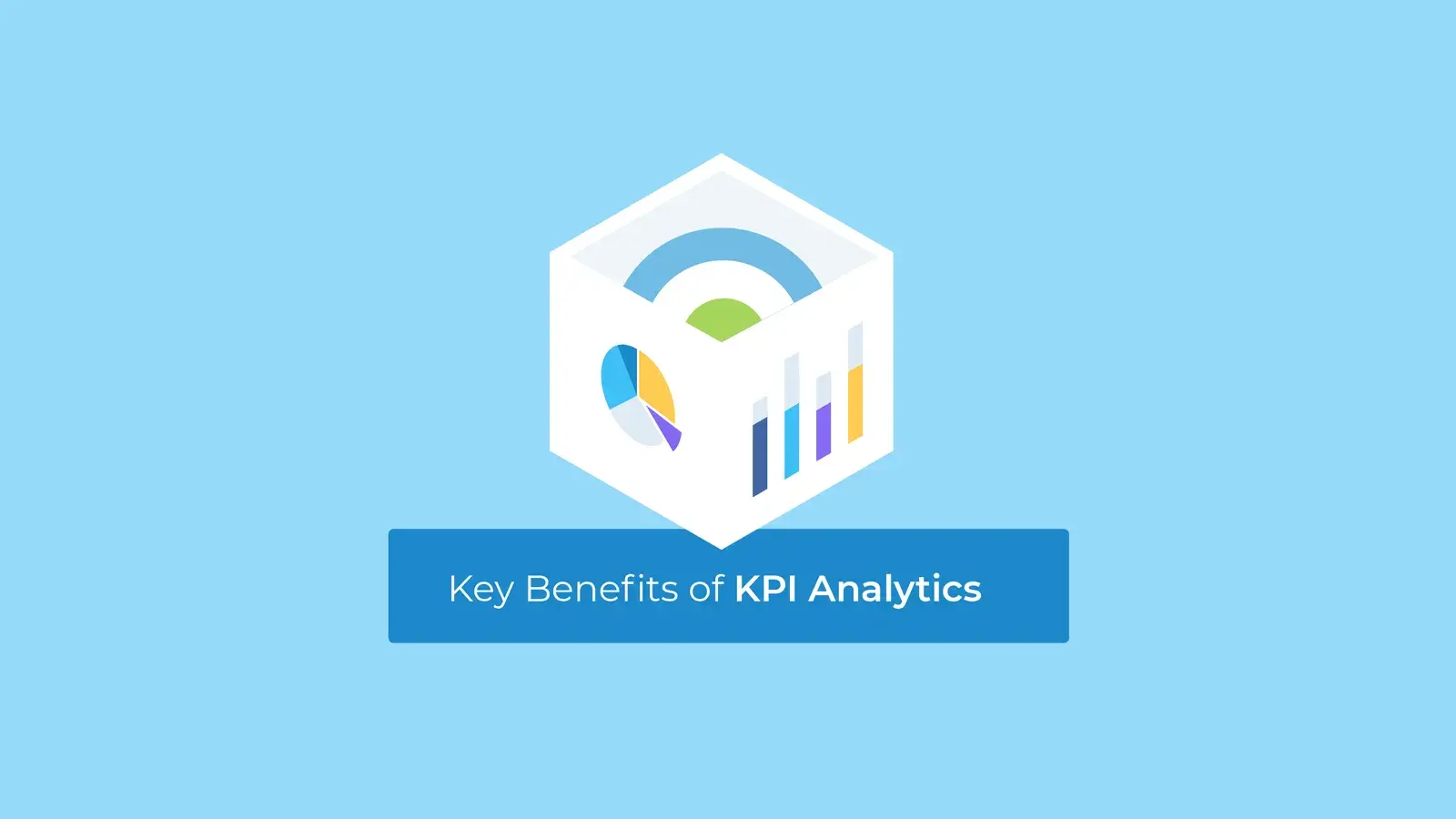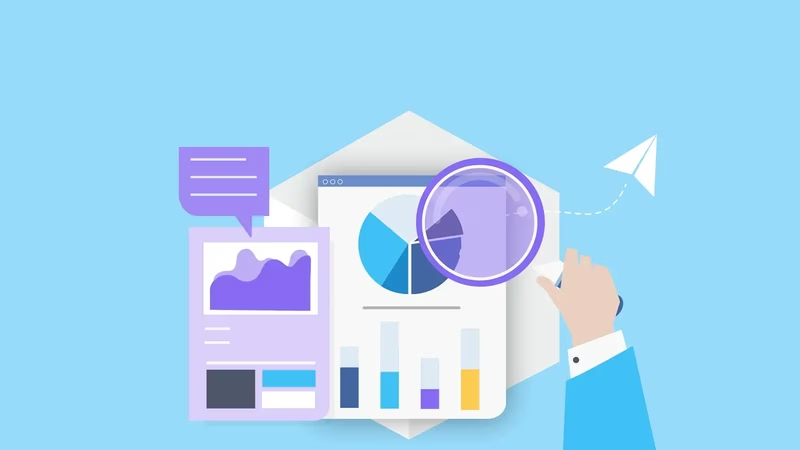In this Guide:
- About this guide
- What is KPI Analytics?
- Why do companies Analyse KPIs?
- What are the benefits of KPI Analysis?
- How to Analyse KPIs, Metrics, and Measures
- Key Features of KPI Analytics Software
- Conclusion
- More References and Resources
About this Guide
This guide will introduce KPI Analytics and the concept behind analyzing both Key Performance Indicators and the metrics behind these performance measures. We'll cover why companies engage in analysis and the benefits it brings, highlighting the most efficient analysis strategies and how to implement these within your organization.
What is KPI Analytics?
KPI Analytics is the process of analyzing Key Performance Indicators, including the data and metrics used in KPI formulas. Analysis of these metrics answers anomalies in graphs and charts typically used to visualize KPIs. Data analysts and senior managers use analytics to gain insight into processes, streamline efficiencies, and highlight opportunities.
KPI analytics is an integral part of monitoring the health of a business or project and was used primarily to determine the root cause of incidents.
However, companies are now leveraging KPI analysis to develop better products for their customers, mitigate risk and increase revenue. Using analysis correctly can facilitate far better decision-making than relying on KPIs alone.
Start Analyzing your KPIs
Why do Companies analyze KPIs?
Companies that use KPIs and analyze the data perform far better than their competitors.
A study of over 350 businesses by the Aberdeen Group concluded that organizations that use (and Analyse) KPIs performed far better than their competitors.
These gains included a 10% increase in decision-making time, a 9% rise in profitability and revenue growth, and a 9% improvement in customer performance.
Specifically, companies use KPI Analytics with three key objectives in mind:
-
To look for opportunities
KPIs are a good indicator of how a company is performing and an excellent tool for spotting new business opportunities.
Generally, companies use KPIs to monitor their performance against a specific goal. In many cases, this means tracking, for example - how well they are meeting revenue targets.
However, companies now have many data points at their disposal when analyzing performance; they will now use the metrics that feed the revenue KPIs to look for niches in sales that could be exploited by marketing or sales promotions.
-
To investigate the underlying data and to look for efficiencies
Companies analyze KPIs to investigate the underlying data and to look for efficiencies. They use this information to determine what areas need more attention. Companies will then use this data to develop future strategies for their growth.
-
To maintain the KPI's effectiveness
Objectively analyzing the performance of different KPIs will help improve operational effectiveness. By looking for things that are succeeding and ones that need improvement, they can use their resources more effectively and maintain high-performance levels.
What are the Benefits of KPI Analysis?
The benefits of KPI Analysis are relatively broad; they can be as straightforward as simply ensuring that performance is on track. Or, they can be as sophisticated as deep-diving into data to look at subtle changes in outputs that, if tweaked, could improve performance fractionally. However, there are five main areas that companies routinely benefit from when implementing a KPI Analysis strategy.

-
Mitigating Risk
By leveraging KPI analytics, companies can better position themselves to measure and calculate their risk position. These steps help to mitigate risks before they become problems or losses.
-
Delivering or adapting services or products to consumers
The success of nearly all businesses depends on its ability to give the customers what they want.
So it is important to get insights from customers to see which products or services are working and what needs improving or adapting. These insights help you understand the customer's mindset and market demand, driving your product development strategy.
-
Optimizing & Improving the Customer Experience
Analyzing customer interactions from the perspectives of 'What Happened,' 'what might happen' and 'What might be done, allows companies to offer a more consistent and personalized experience and helps streamline operations.
-
Better Decision-Making
https://medium.com/data-science/using-analytics-for-better-decision-making-ce4f92c4a025
From using KPI data to drive product development to match consumer markets - to using data to personalize services, companies use KPI Analytics to enable faster and fact-based decision-making.
For example, KPI reporting and dashboards can help identify data relationships, providing managers with facts to base decisions that would be otherwise impossible.
-
Better financial insights, reducing costs, and increasing profit
Detailed analysis leveraging balance sheets, cash flow, and budgets can help an organization better understand its financial health. Looking deeper into expenses such as material costs can provide cost reduction and increased profits.
How to Analyse KPIs, Metrics, and Measures
Analysing KPIs falls into two main classifications.
The Reactive approach is when the data is only analyzed when there is a problem. It does not improve the performance of the company and instead solves problems as they arise.
The Proactive approach is when companies analyze their data regularly to identify potential issues and fix them before they happen.
Both approaches can be defined in 5 main steps:
-
Setout your aims
Before starting to analyze, you will need to define a clear set of goals that cover the problem or issue you're trying to resolve. This will then provide a framework of the data you will need.
-
Define your measures
For example, if you need to measure sales by agents, you might want to delve into the data find out how long each sales cycle per rep takes. Then, measure each rep's sales performance against the team's average.
-
Collect your data
Defining and collecting data should be relevant to the aims set out in step 1. Most related data will already be stored in current applications, databases, and spreadsheets. Here quality is king. It's worth spending the time checking accuracy and cleansing data where needed.
-
Analyze your data
KPI Analytics tools such as dashboards and reports are an excellent way to begin digging into your data. Most will already have an element of automation and templates to get you started. Some will already cover the many analysis methods you can use in your strategy.
Once you have a method, it can either be applied via an app or manually.
-
Visualize your KPIs and the results
Once you've got the data, method, and aim, you can start putting the cool-looking stuff together. This is typically achieved via KPI Dashboards, where complex data can be transformed into insightful visuals, with the benefit that all stakeholders can quickly understand the data. Alternatively, KPI reports that summarize the data in tabular format are often used.
Key features of KPI Analytics Software
Utilizing KPI Analytics software brings clear benefits to companies, stakeholders, and staff. But what are the key attributes to look for when selecting the right KPI Analytics software?
- Simplicity is Key; being intuitive and flexible will get you up and running in less time.
- A good KPI analytics application should be customizable to allow the user to create different charts or reports for various departments or teams.
- The information should be easy to break down, save, and share securely.
- Mobile access makes decision-making more consistent with constant access to the information needed to guide them.
- A wide variety of automated data sources will get the data into a format to be analyzed alongside other related data.
- A versatile KPI Dashboard will ensure you can visualize the analysis of your data; this includes sharing insights with colleagues quickly.
Conclusion
Analyzing KPIs on a regular basis provides organizations with the information needed to understand what is working and what needs to be improved.
Collection of this data is now easier than ever, thanks to both data integration providers and analysis tools increasingly automating this process.
These advances now mean that analyzing KPIs is not just for larger organizations but is attainable for every business. Allowing companies to now put their data to work to optimize their processes, mitigate risk and, make better decisions.
Get started by setting out your goals, then let KPI Software such as SimpleKPI handle the management and visualization of your analysis.
Sign up for a free trial to see how simple it is to track and analyze your KPIs on dashboards and reports.
More References and Resources
How to analyze data
https://monkeylearn.com/blog/how-to-analyze-data
Key Features of Analysis Software
https://dzone.com/articles/what-are-important-features-of-analytics-software
Benefits of Data Analysis
https://www.teradata.com/Blogs/5-Big-Benefits-of-Data-and-Analytics-for-Positive-Business-Outcomes
Why you shouldn’t use Spreadsheets for KPIs
https://www.youtube.com/watch?v=VJ1JhiANL8c
5 Reasons Data Analytics is Important for Every Business
https://businesspartnermagazine.com/5-reasons-why-data-analysis-is-important-for-every-business

by Stuart Kinsey
Stuart Kinsey writes on Key Performance Indicators, Dashboards, Marketing, and Business Strategy. He is a co-founder of SimpleKPI and has worked in creative and analytical services for over 25 years. He believes embracing KPIs and visualizing performance is essential for any organization to thrive and grow.
